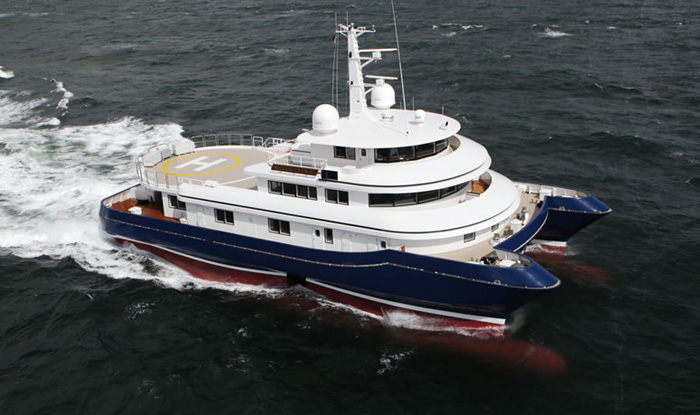
SWATH Ships
Small waterplane area twin hull (SWATH) is a twin-hull ship design that minimizes hull volume in the surface area of the sea. By minimizing hull volume in the sea’s surface, where wave energy is located, the vessel becomes very stable, even in high seas and at high speeds. The bulk of the displacement necessary to keep the ship afloat is located beneath the waves, where it is less affected by wave action, as wave excitation drops exponentially with depth. Placing the majority of the ship’s displacement under the waves is similar in concept to submarines, which are also not affected by wave action.
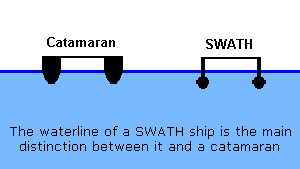 The twin-hull design provides large, broad decks and a stable platform. The main disadvantages to the SWATH hull form are that they are more expensive than conventional catamarans, require a complex control system, have a deeper draft than catamarans and mono-hulled ships, and a higher maintenance requirement. Furthermore, SWATH vessels can use up to 80% more power than an equivalent catamaran, and are more limited in speed compared to equivalent catamaran vessels
The twin-hull design provides large, broad decks and a stable platform. The main disadvantages to the SWATH hull form are that they are more expensive than conventional catamarans, require a complex control system, have a deeper draft than catamarans and mono-hulled ships, and a higher maintenance requirement. Furthermore, SWATH vessels can use up to 80% more power than an equivalent catamaran, and are more limited in speed compared to equivalent catamaran vessels
The SWATH design gives exceptional stability in high seas. This is accomplished by placing most of the ship’s displacement below the level of the waves (like a submarine) where all the kinetic energy of the sea surface is located. Conversely, ships with traditional hull designs have most of their displacement in the wave level of the sea, causing them to roll and pitch in the waves.
Abeking & Rasmussen shipyards can refer to their elementary experience in the building of SWATH ships. The specific characteristics of this type of ship offer such space and comfort in the field of mega-yacht that they can satisfy the most extravagant owner’s desires and open totally new dimensions.
Besides the generous areas on each deck, one is impressed by the operation ability which is independent of the seastate and enables unspoilt enjoyment of maritime lifestyle. Salons with unprecedented areal space, free balconies and generously dimensioned free zones enable a pleasant stay of board even in rough seas and opens up adventurous worlds, which conventional yachts have nothing to set against. with a wide range of shops, which fulfil very specific demands and have to guarantee a high technological standard
Buoyancy
The buoyancy of a SWATH ship is provided by two submarine hulls connected to the upper platform by twin narrow struts from each of the submarine hulls. This mature technology used by the military and for deep-sea research ships. Until now, it has not been available in a private yacht. Very simply the hull form reduces the upward forces on the vessel as the wave passes through. The biggest advantage comes in a beam sea because the technology significantly reduces the vessel’s vertical movement and totally eliminates the quick jarring movements. The idea of SWATH was taken from the principle of submarines at periscope depht, which has been shown to have minimal or no motion, placing most of the ship’s displacement under the waves.

The Small Waterplane Area Twin Hull is a twin-hull ship design that minimizes hull volume in the surface area of the sea. By minimizing hull volume in the sea’s surface, where wave energy is located, the vessel becomes very stable, even in high seas and at high speeds. The bulk of the displacement necessary to keep the ship afloat is located beneath the waves, where it is less affected by wave action, as wave excitation drops exponentially with depth.
Advantages are: (1) ability to deliver big-ship platform steadiness and ride quality in a smaller vessel and (2) ability to sustain a high proportion of its normal cruising speed in rough head seas. SWATH ships typically have two submarine-like lower hulls completely submerged below the water surface. Above water, a SWATH resembles a catamaran.
However, the purpose for a balanced Small Waterplane Twin Hull ship design is NOT to minimize ship motions at the expense of speed-power or payload capabilities. During the design process, if the total amount of strut waterplane area is decreased, the transverse spacing between the hulls must be increased to regain adequate transverse stability to resist heeling over moments as a result of wind or movement of all passengers to one side of the ship.
Adequate clearance to the underside of the connecting structure is also essential to allow the Small Waterplane Twin Hull ship to ride over surface waves that are typically present in coastal waters. This type of operating mode results in the smallest vertical motions and is called platforming. For rough seas, with wave heights exceeding the amount of cross-structure clearance, SWATH ships are designed to have a sufficiently short heave period to provide inherent contouring behavior at low speeds.

New Construction Project SWATH
Dutch Loodswezen has decided to make use of a new type of ship with regards to the piloting of sea-going vessels. As a result of employing SWATH, the trustworthiness of the pilots’ services will be further enhanced. This will mean that, in the future, pilotage will be suspended for a mere few days a year in adverse weather conditions.
The vessel, which is 26 meters in length, is extremely stable as a result of two floating bodies that form part of the hull. This construction makes it highly seaworthy. The small surface area on the water-line, means that waves have a minimal impact on the vessel. Moreover, stability fins in both the floating bodies, which are computer controlled, enhance the overall behaviour of the vessel when underway by controlling and minimizing its rolling and pitching movements. Additionally, the SWATH can be lowered in the water (through increasing its ballast) by around 80 centimetres within the space of five minutes, enabling ships with a lower freeboard to be boarded by pilots more easily and safely.

The SWATH will be used to enable the piloting of vessels, taking over the tasks of both pilot boats and yawls. It will take the pilot to the incoming ship and will permanently patrol the piloting area. During its trials, its logistical processes will be closely followed and, where necessary, adjusted. As a result, the bringing into use of SWATH vessels by Loodswezen will offer a great contribution to realising the permanent accessibility of ports. They will be employed in the coastal waters off Hoek van Holland, IJmuiden, and in the Schelde area.
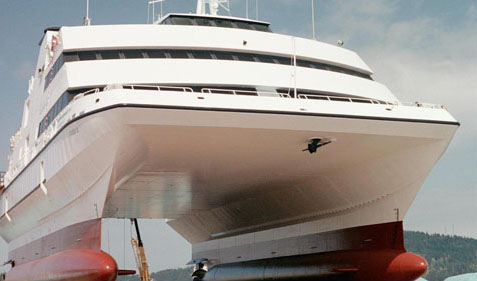 Cloud X is a SWATH Vessel. The beam of the Cloud X at 59.3 ft. is almost half its length (123.1 ft), so deck utilization is much better than the conventional long narrow decks. Its beaminess requires less pier space than a conventional vessel of equivalent tonnage. These advantages make it a good choice for the Commercial day ferry. During its six month service from West Palm Beach, FL to Freeport on Grand Bahama Island, passengers were quite pleased with the ride and the amenities, with many repeat passengers. If only the ridership were as good as the ride she’d still be plying the route.
Cloud X is a SWATH Vessel. The beam of the Cloud X at 59.3 ft. is almost half its length (123.1 ft), so deck utilization is much better than the conventional long narrow decks. Its beaminess requires less pier space than a conventional vessel of equivalent tonnage. These advantages make it a good choice for the Commercial day ferry. During its six month service from West Palm Beach, FL to Freeport on Grand Bahama Island, passengers were quite pleased with the ride and the amenities, with many repeat passengers. If only the ridership were as good as the ride she’d still be plying the route.
Megayacht: With the good seakeeping, over 4714 square feet of main deck and over 3370 square feet of upper deck, the Cloud X could be refitted as a luxurious, sleek megayacht.
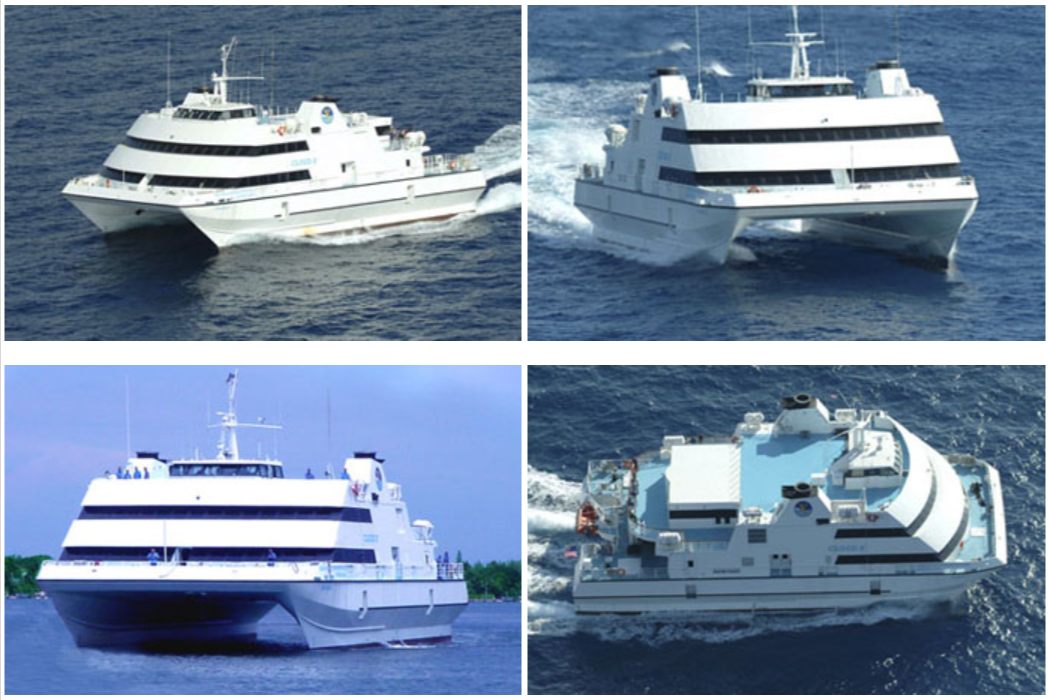
Oil rig crew boat: The SWATH design has been selected by Trico Marine Services as the design of choice to accommodate their needs for high-speed transportation of offshore rig personnel to and from platforms in the rough waters of Campos Basin on the coast of Brazil. The cost of flying crew by helicopter and risk attached to this operation made companies like Trico to look closely at ship designs that could operate in sea conditions that would prevent conventional supply ships to sail and be economical enough to run. The M/V Cloud X would be an ideal crew boat. It is certificated to carry 365 passengers with baggage and cargo. The vessel range is 200 nm and was certified by United States Coast Guard to operate in seas up to 4.0 meters. The Cloud X is currently berthed in Florida
Cloud X Specifications
Hull Form: SWATH | Hull Material: Aluminum
Length (feet): 123 | Beam (feet): 60 | Max speed: 27 knots
Trailer: Sold separately

Suncruz VI represents the many firsts in the Ocean-going small passenger vessel industry. She is the first SWATH delivered for the Gaming business. She is also the largest passenger-carrying SWATH ever constructed in the U.S. She is the largest passenger (or any other) SWATH, admeasuring under 100 Gross Tons. She is the first passenger SWATH to feature “variable draft”.
This vessel provides the latest technology in passenger comfort by reducing ship motions. The SWATH design, which is noted for its extremely comfortable ride in rough seas, is extremely beneficial on the East Coast where cruise cancellations due to bad weather, rough rides and severe seasickness have severely plagued the industry. Seasickness has been responsible for Offshore Gaming business failures. Monohulls in the 160′ length range won’t go out in seas higher than 5 feet. If they do, 40% or more of the patrons will get seasick. In comparison, SUNCRUZ VI recently went out in 7 foot seas with 400 passengers, and only one (1) person became seasick. Considering the above, the approximately 30-40% increase in construction costs seems cheap. This type of vessel design will also be well-suited to other locations along the Eastern Seaboard, particularly in the Northeast as gaming cruises outside the International Boundary are starting.
The vessel is designed for USCG certification under Subchapter “K”, Passenger Vessels less than 100 Gross Tons. Her capacity will be 600 passengers plus 150 crew, for service on partially protected waters, 20n.m. from harbor of safe refuge. The vessel is a 3-deck vessel, with 600 gaming positions. The Casinos are very spacious due to the wide beam of the SWATH design. The Main Deck features a large Casino area, sports bar and galley area. The 2nd Deck features a large Casino and snack area. The 3rd Deck features an open entertainment lounge and sun deck, as well as the Pilothouse. All decks are served by an elevator. Propulsion, electrical and other machinery are located in the lower hulls. Propulsion is provided by Detroit Diesel 12V-149TI DDEC engines through ZF Marine gears. Electrical power is provided by 720kW Detroit Diesel 16V-92 TA’s. A 400 hp Schottel bow thruster is powered by a Detroit Diesel 12V-71N.
“The SWATH is the vessel of the future for the Offshore Gaming Industry”, according to Andy Lebet, Vice President of DeJong and Lebet, Inc. “The passenger comfort in rough seas will be a primary selling point for the operation, as well as the increased reliability as far as keeping to the cruise schedule, in spite of bad weather”. However, keeping SWATH design simple will be the key to keeping construction costs at acceptable levels, according to Norman DeJong. We have proven in SUNCRUZ VI that this can certainly be done.
Suncruz VI Specifications
Length: 160 ft.
Beam: 65 ft.
Depth: 23 ft.
Draft (Ballasted): 15 ft. (Unballasted): .9 ft.
Speed: 10 knots
Hull Construction: Steel

The Planet – The Type 751 Planet of the German Navy is the most modern naval research ship within NATO. It was built as SWATH design in order to reduce the hull volume and to increase the ship’s stability – particularly in high seas and at high speed. It is used for geophysics and naval technology trials and research. While technically not armed, it is equipped with torpedo launch capability. Also other weapons systems can be installed for weapon trials.
Displacement: 3,500 tonnes (3,445 long tons)
Length: 73 m (239 ft 6 in)
Beam: 27.2 m (89 ft 3 in)
Draft: 6.8 m (22 ft 4 in)
Speed: 15 knots (17 mph; 28 km/h)
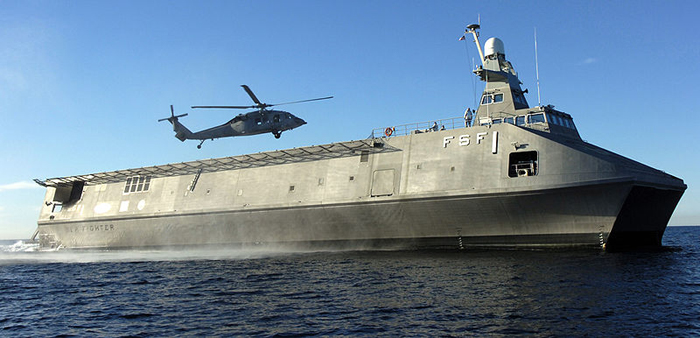
Sea Fighter (FSF-1) is an experimental littoral combat ship under development by the United States Navy. Its hull is SWATH design, constructed out of aluminum. The ship can operate in both blue and littoral waters. It can be easily reconfigured through the use of interchangeable mission modules. Helicopters can land and launch on its deck. Smaller water craft can be carried and launched from its stern.
With twin gas turbine engines, twin water jets, and a streamlined hull, Sea Fighter is capable of speeds of 50 knots (90 km/h) and greater. It is designed to be a sea frame that can carry interchangeable mission modules resembling shipping containers. These modules allow it to be easily reconfigured to meet a variety of mission requirements. The mission modules are easily loaded and stored on Sea Fighter’s inner deck.
The basic design has a displacement of 1,100 tons while measuring 73 m long and 22 m broad. Power is provided by a CODOG arrangement comprising two MTU 595 diesel engines and two LM2500 gas turbines. Diesel power is used for cruising while the turbines provide high power output for high speed operation. The two gas turbines power the vessels twin water jets, drawing water from the bottom stern of each hull and powering it through large water turbines, which are responsible for the vessel’s remarkable speed. Each water jet has thrust vectoring and thrust reversers making it possible for Sea Fighter to move sideways while docking, or even traveling in reverse. Thrust vectoring also makes it possible for Sea Fighter to make dramatic evasive maneuvers while traveling at high speed. This would prevent the craft from being forced to shore or into the path of enemy vessels.
The forward superstructure consists of a bridge on the lower deck, and a flight operations station on top. The bridge is relatively small, and generally manned by a crew of three. The bridge control stations incorporate glass displays using the latest in navigational aids to assist Sea Fighter in patrolling coastal areas while operating at high speed. Maneuvering Sea Fighter is more reminiscent of the operation of a Landing Craft, Air Cushioned (LCAC) than a conventional warship. Above the bridge is a small flight operations station with room for only one operator. This glass enclosed station provides an excellent view of the entire flight deck, and allows the operator to coordinate the approach and landing of helicopters, and loading of the vessel’s mission containers, as well as providing visual aid for navigation.
The ship has a modern computer system to control its systems and for navigation. Steering and throttle control are done by wire rather than mechanical linkage.
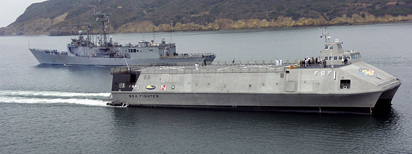 The Navy and Coast Guard are jointly exploring the possibility of further development of Sea Fighter-type vessels for use in patrolling U.S. coastal waters. With an effective range of 4,400 nautical miles (8,100 km) unrefueled the type could also be deployed quickly overseas for similar duties. Sea Fighter is expected to pave the way for a future line of fast, long range destroyers capable of travelling fast enough to avoid or out maneuver most of the current generation of torpedoes. Such vessels would be capable of crossing the Atlantic Ocean unrefueled, and have a very low radar signature, making detection difficult. They would be able to respond quickly to targets located by air or satellite and aggressively attack surface and submerged vessels using their speed to evade torpedo and missile attack.
The Navy and Coast Guard are jointly exploring the possibility of further development of Sea Fighter-type vessels for use in patrolling U.S. coastal waters. With an effective range of 4,400 nautical miles (8,100 km) unrefueled the type could also be deployed quickly overseas for similar duties. Sea Fighter is expected to pave the way for a future line of fast, long range destroyers capable of travelling fast enough to avoid or out maneuver most of the current generation of torpedoes. Such vessels would be capable of crossing the Atlantic Ocean unrefueled, and have a very low radar signature, making detection difficult. They would be able to respond quickly to targets located by air or satellite and aggressively attack surface and submerged vessels using their speed to evade torpedo and missile attack.
Displacement: 950 tons
Length: 262 ft (79.9 m)
Beam: 72 ft (22 m)
Draft: 11.5 ft (3.5 m)
Propulsion: Combined diesel or gas turbine
Speed: 50 knots (90 km/h)
Range: 4,400 nautical miles (8,100 km)
 USNS Impeccable (T-AGOS-23) is an Impeccable-class ocean surveillance ship acquired by the U.S. Navy in 2001 and assigned to the Navy’s Special Missions Program. The ship is a designated T-AGOS vessel built to tow a Surveillance Towed Array Sensor System.
USNS Impeccable (T-AGOS-23) is an Impeccable-class ocean surveillance ship acquired by the U.S. Navy in 2001 and assigned to the Navy’s Special Missions Program. The ship is a designated T-AGOS vessel built to tow a Surveillance Towed Array Sensor System.
The ship’s catamaran-type small waterplane area twin hull (SWATH) design prevents the vessel from rolling in heavy seas and gives additional deck space for storing the acoustic equipment. The mission of Impeccable is to directly support the Navy by using SURTASS passive and active low frequency sonar arrays to detect and track undersea threats.
Length: 281.5 feet
Beam: 95.8 feet
Draft: 26 feet
Displacement: 5,368 long tons
Speed: 12.0 knots
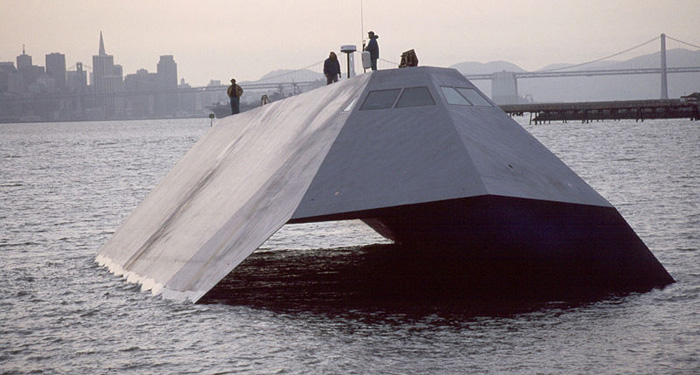
Sea Shadow (IX-529) was an experimental stealth ship built by Lockheed for the United States Navy in 1985 and used in secret. to examine the application of stealth technology on naval vessels. Sea Shadow has a SWATH hull design. Below the water are submerged twin hulls, each with a propeller, aft stabilizer, and inboard canard. The portion of the ship above water is connected to the hulls via the two angled struts. The SWATH design helps the ship remain stable even in very rough water of up to sea state 6 (wave height of 18 feet (5.5 m) or “very rough” sea).
Sea Shadow was revealed to the public in 1993, and was housed at the San Diego Naval Station until September 2006, when it was relocated with the HMB-1 to the Suisun Bay Reserve Fleet in Benicia, CA. The vessels are available for donation to a maritime museum. The Sea Shadow was never a fully commissioned ship of the US Navy
Displacement: 563 tons / 572 tonnes
Length: 164 ft / 50 m
Beam: 68 ft / 21 m
Draft: 15 ft / 4.6 m
The SWATH form was invented by Canadian Frederick George Creed (1871–1957) a Canadian inventor, who presented his idea in 1938 and was later awarded a British patent for it in 1946. It was first used in the 1960s and 1970s as an evolution of catamaran design for use as oceanographic research vessels or submarine rescue ships

